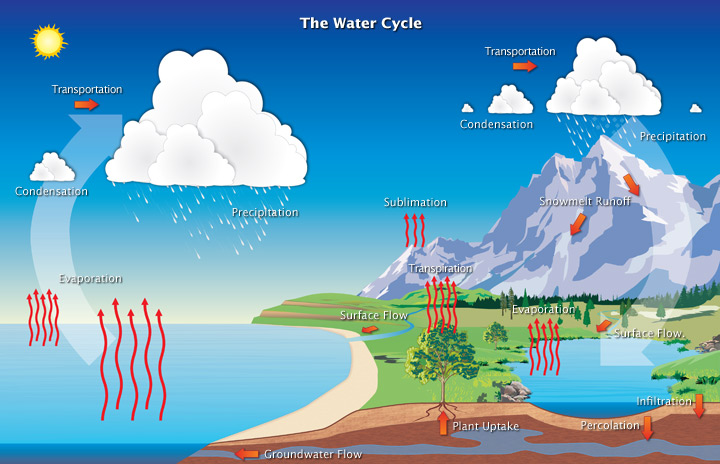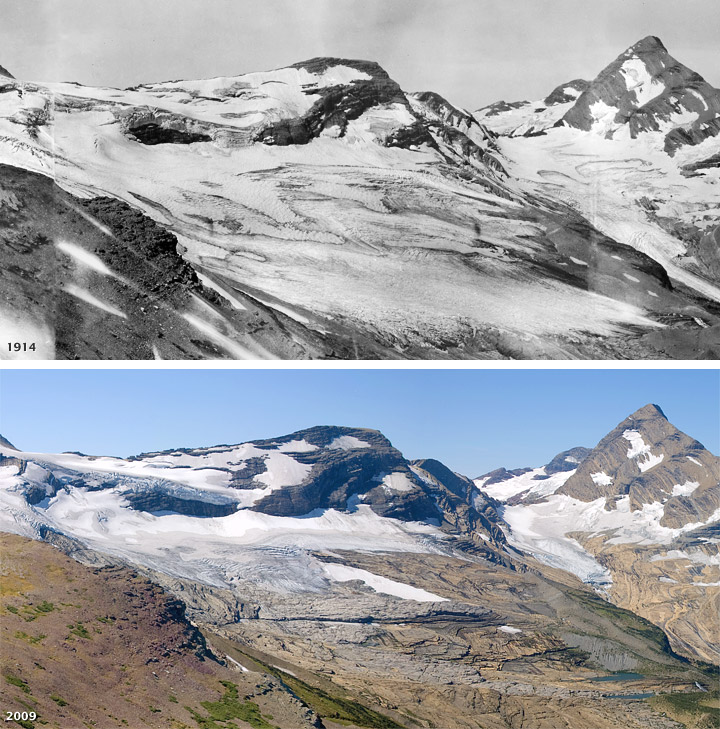The water, or hydrologic, cycle describes the journey of water as water molecules make their way from the Earth’s surface to the atmosphere and back again, in some cases to below the surface of the Earth. This gigantic system, powered by energy from the Sun, is a continuous exchange of moisture between the oceans, the atmosphere, and the land.

Earth’s water continuously moves through the atmosphere, into and out of the oceans, over the land surface, and underground. (Image courtesy NOAA National Weather Service Jetstream.)
Water evaporation—the process by which water changes from a liquid to a gas by gaining heat energy— comes from saltwater: oceans/seas andFreshwater:lakes, rivers, streams.
5th grade does not need to know the words transpiration, sublimation, or volcanic emissions.
After the water enters the lower atmosphere, rising air currents (wind) carry it upward, often high into the atmosphere, where the air is cooler. In the cool air, water vapor is more likely to condense from a gas to a liquid to form cloud droplets because the molecules lose heat energy. Cloud droplets can grow and produce precipitation (including rain, snow, sleet, freezing rain, and hail), which is the primary mechanism for transporting water from the atmosphere back to the Earth’s surface.
When precipitation falls over the land surface, it follows various routes. Some of it evaporates, returning to the atmosphere; some seeps into the ground as soil moisture or groundwater; and some runs off into rivers and streams. Almost all of the water eventually flows into the oceans or other bodies of water, where the cycle continues. At different stages of the cycle, some of the water is intercepted by humans or other life forms for drinking, washing, irrigating (water used in farming), and a large variety of other uses.
Groundwater is found in two broadly defined layers of the soil, the “zone of aeration,” where gaps in the soil are filled with both air and water, and, further down, the “zone of saturation,” where the gaps are completely filled with water.
Water can be stored in glaciers, land ice, and ice caps.

Blackfoot (left) and Jackson (right) glaciers, both in the mountains of Glacier National Park, were joined along their margins in 1914 (snow from each moutain met in the middle), but have since retreated (melted away) into separate alpine cirques (snow no longer touches). The melting of glacial ice is a major contributor to sea level rise. [Photographs by E. B. Stebinger, Glacier National Park archives (1911), and Lisa McKeon, USGS (2009).]
Throughout the water cycle, there are many paths that a water molecule might follow. Water at the bottom of Lake Superior may eventually rise into the atmosphere and fall as rain in Massachusetts. Runoff from the Massachusetts rain may drain into the Atlantic Ocean and circulate northeastward toward Iceland, destined to become part of a floe of sea ice, or, after evaporation to the atmosphere and precipitation as snow.
Water molecules can take an immense variety of routes and branching trails that lead them again and again through the three phases of ice, liquid water, and water vapor. For instance, the water molecules that once fell 100 years ago as rain on your great- grandparents’ farmhouse in Iowa might now be falling as snow on your driveway in California.
This information was taken from the website: https://earthobservatory.nasa.gov/features/Water/page2.php. Parts were edited to explain vocabulary words and take out some information.
Lesson 1: Where is most of the water on Earth stored?
Resources:
1. https://www.usgs.gov/special-topic/water-science-school/science/how-much-water-there-earth?qt-science_center_objects=0#qt-science_center_objects Explains where water is located on Earth. This website includes helpful graphs and other images to better understand water locations.